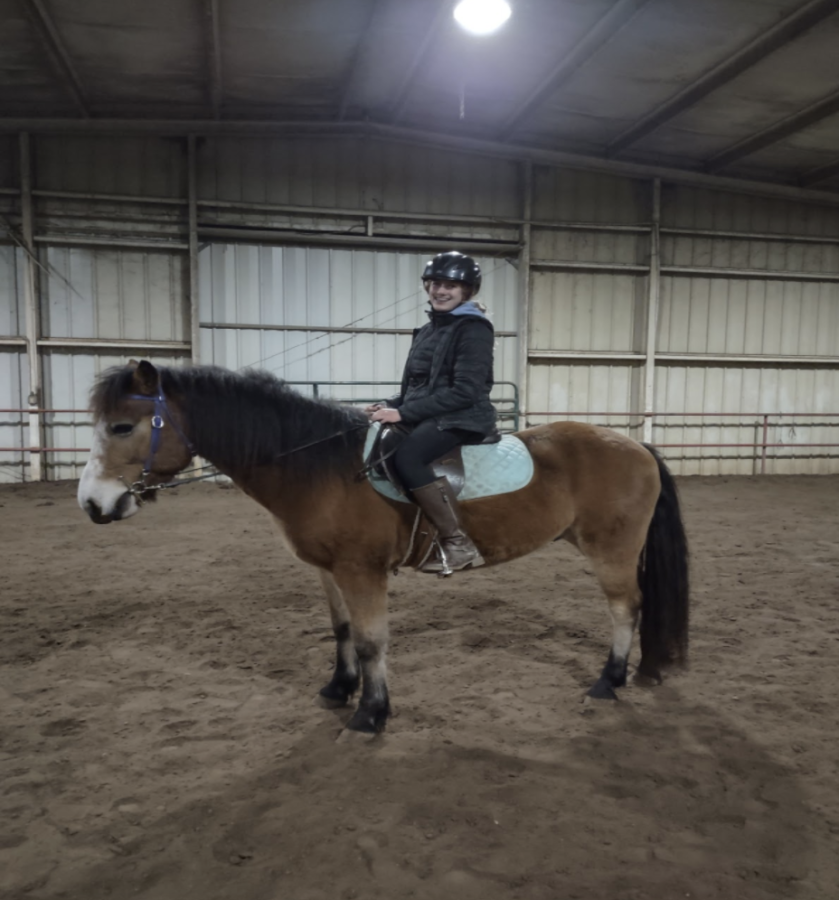Combined Driving and English Competitions: A guide to horse competitions
Charley is being ridden by Hadley Leftin in the correct posture.
There are three main categories for horseback riding competition: English, Western, and Combined Driving, which each have competitions inside of them.
The roots of English riding are in the fox hunting fields of England, and Classical Riding High School which is located in Austria, France, and Germany.
There are six different specialties in English competitions, which include show hunter, show jumping, eventing, dressage, combined driving, and saddle seat.
Combined Driving:
Combined Driving is a test of obedience, endurance, skill, and agility. One of the many benefits of competing in this type of competition is that most horse breeds can participate because the size of the horse isn’t influenced by this competition.
The horse(s) and rider(s) compete in three activities Dressage, Cross-Country Marathon, and Cones. The whole competition takes about three days each phase of activity tests the ability of the horse and driver and their training. This is tested in every competition but this is the main test in driving.
The first activity is Dressage which tests the horse’s submission, flexibility, and balance, as well as the rider’s memorization and execution of their test correctly.
The second activity is the Cross-Country Marathon which tests the horse’s endurance and stamina over a long distance, and the horse and rider’s ability for negotiating obstacles on the course.
Lastly, the third activity is Cones which tests the horse’s and rider’s concentration and precision when they maneuver between the sets of cones on the course without knocking them down.
Saddle Seat:
Saddle seats were devised to exhibit the beauty and movement of the horse and were developed to show off the flashy gaits of American breeds.
There is no jumping involved in the Saddle Seat and it is all done on flat ground. The horses have their head held high, their neck arched and upright, show-off their attitude, and their ears pricked forward. They move with a comfortable high stepping trot and a smooth rocking canter.
To be in the Park Horses Division requires horses with the most spectacular and high stepping gaits. If your horses have less flashy movements, they still need to fulfill other requirements that are shown in pleasure classes. Pleasure classes are when the horse is only judged the rider isn’t judged.
Show Hunter:
Show Hunters are judged on their ability to jump a course of natural-looking obstacles at the right pace and the correct amount of strides. Their appearance is also judged such as tack, grooming, and uniform.
Hunter horses are usually more relaxed than event horses or jumpers, as they cover the ground with long and elegant strides.
Hunter classes are not only offered for jumping competitions but also breed shows, such as Arabian, Paint, and Quarter horses.
Dressage:
Two thousand years ago Dressage was developed to make cavalry horses nimbler and more responsive on the battlefield.
Dressage battle movements were demonstrated in front of kings and queens to show them the might and power of their horses. This ended up becoming the sport’s modern Grand Prix test upholding traditions and methods.
All horses can benefit from learning Dressage moves. A competitive Dressage horse should possess a healthy conformation. Dressage competitions at any level are the ultimate test to determine whether harmony between horse and rider has been met or still needs to be met.
Show Jumping:
Show Jumping evolved from going place to place and having to jump obstacles in the middle 1800s. Back then, Show Jumping consisted of one jump that got higher and higher which is now known as a high jump.
The horse jumps over many-colored fences that are put up in a challenging pattern. When a horse knocks down a jump or refuses to go over a jump the rider gets a penalty. If they make a clean round they move to the jump-off where the course is shorter, the jumps continue to get higher and they are going against a clock.
Eventing:
Eventing has three parts also known as the triathlon of all English equestrian sports. These three parts are dressage, cross-country jumping, and show jumping or stadium jumping.
The Dressage test displays submission and obedience, as the cross-country course demonstrates ability and obedience over miles of obstacles, and the Show Jumping tests show that the horse is in good condition to jump a hard course of colored fences.
The horse will need good obedience and movement for Dressage competitions, crafty jumping skills for Show Jumping, and speed and endurance to tackle fixed obstacles on the cross-country course.
Thoroughbreds used to be the most popular in eventing, however, this has shifted to warmbloods and cross-bred sport horses in eventing more than there ever were before.
From Combined Driving, Saddle Seat, Show Hunter, Dressage, Show Jumping, to Eventing horses can do just about anything they set their mind to. These competitions take time and patience just like any other sport does.
Your donation will support the student journalists of Highlands High School. Your contribution will allow us to cover our annual website hosting costs.



